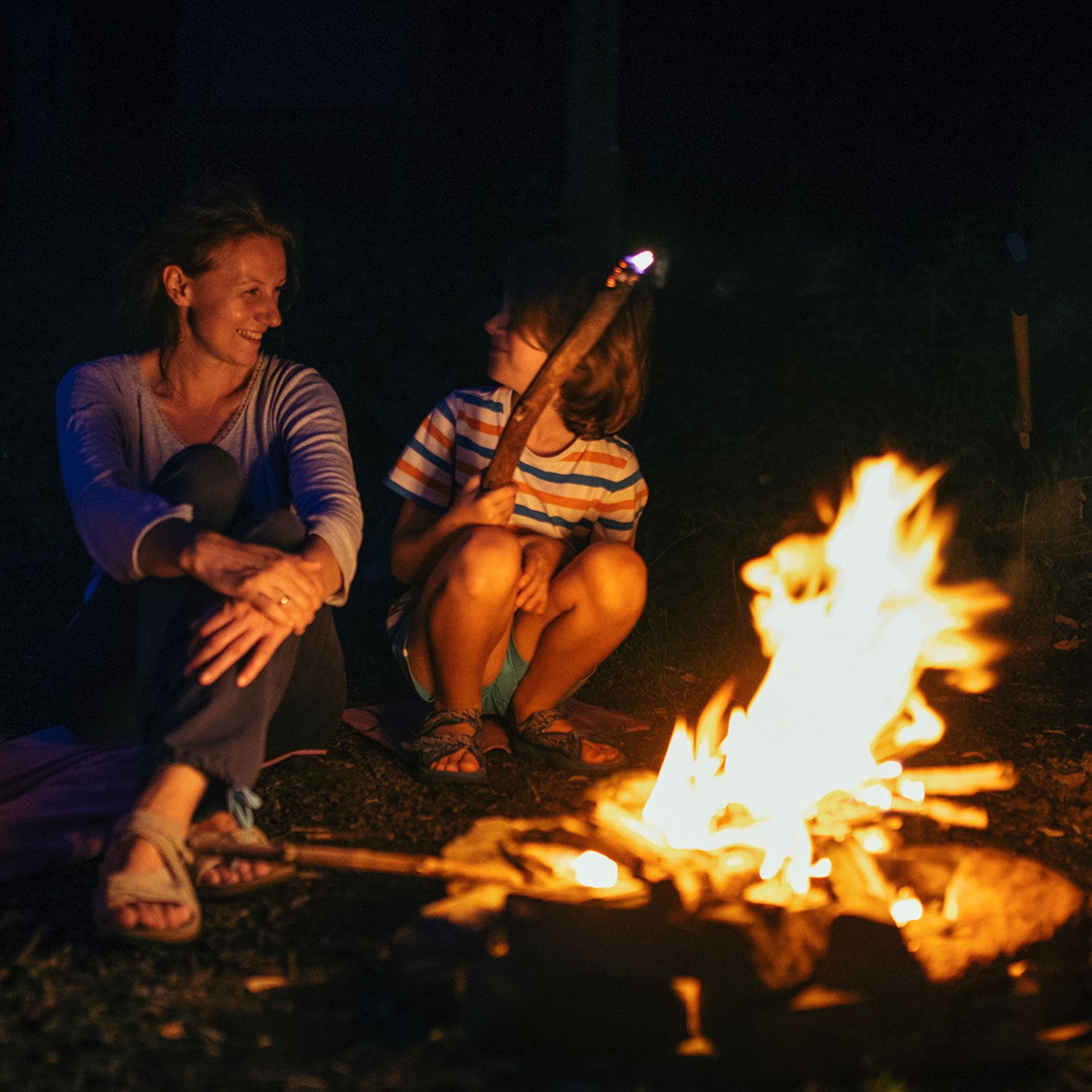One September a few years ago, when my daughters were five and seven, we went rafting down the Green River. On the last night, as we had all the previous nights, we built a small campfire on a sandbar. It was the last day of summer, and we’d spontaneously decided to stay on the river for an extra night, camping on a beach so pearly and fine it seemed impossible that we were in the desert.
My daughters and their friends gathered around and asked for a campfire story. I know many avid and capable outdoor parents, but I don’t know a single one who doesn’t groan inwardly a little when a child asks for a campfire story. After going hard all day, it would be nice to sit quietly and watch the flames lick the black night sky and the colors change from orange to crimson and take in the silence of the wilderness.
But it’s human nature to tell—and listen to—stories around a fire. We’ve been doing it since the dawn of time. Jeff English, a tai chi master I know who holds informal fireside storytelling circles, describes it this way: “Before we sat around watching the TV, we sat around watching the fire.”
Campfire Stories for Kids: How to Pull Them Off
Telling a campfire story isn’t hard. It’s helpful to begin with a general narrative, but you don’t need to have the plotlines fully formed in your mind. You can simply begin to talk and let the story lead you. The important thing is to maintain momentum. Don’t dawdle. You’re going for suspense and action, not a long-winded exposition. But don’t rush, either. Kids can always tell when you’re rushing. For little ones, repetition is good; lines that come at predictable intervals create rhythm and serve as a chorus that the kids can repeat with you. Then you can let the fire work its magic. Something about fire makes us talk more truly and listen more deeply.
That night on the Green, the children begged my husband, Steve, to tell his usual story. It was called “Abiyoyo,” based on a , and it was about a giant who lived in village beside a river. Perhaps you know it, too. Steve began to tell it, and I could tell he didn’t want to, but after a few lines—chanting the mesmerizing chorus of “Abiyoyo” like a drumbeat—he was into it. The story had absorbed him, and all of us.
Plot matters: in the end, a band of traveling singers saves the day (don’t they always?) by hypnotizing Abiyoyo into such a deep trance that he falls into the river and is turned from a menacing ogre into a regular-sized man, prompting a dramatic sigh of relief from the kids. But so does collaboration: together, chanting the chorus, the children were making the story their own.
Make Storytelling a Communal Activity
The best campfire story is one that children can learn to tell themselves. After all, isn’t passing the torch the entire point of parenthood? That night, as the flames dwindled and the stars popped out, my older daughter, Pippa, took a turn. “Once upon a time there was a man who crashed his car in the woods and went looking for help. He knocked on the door of a big old rambly house, and a deep, scary voice answered, ‘Waiiiittt till Martin comes.’”
The hair on the back of my neck stood up. Something about this story was familiar—wonderfully, eerily familiar. I knew the refrain before she said it again, the intonation, the long drawn-out vowels. “Waiiiiiiiit till Martin comes.”
The best campfire story is one that children can learn to tell themselves. After all, isn’t passing the torch the entire point of parenthood?
The next day, I was alone in the car, driving north for a writing trip. I’d brought with me old cassettes that my father recorded of my sister and me when we were young. I popped one into my old car’s tape player. A voice came on, young and sweet, familiar. It was my sister, age seven. “Once upon a time,” she began. “A man drove into a tree and knocked on a house.” I cocked my head. I was in Wyoming, in the year 2015. The cassette was dated 1976. In her chirrupy voice, my sister continued, “A voice came through the door, saying, ‘Waiiiiiit till Martin comes.”
Lean on Campfire Stories from Your Own Childhood
Stories live inside us, in recesses of our memories. We carry them in our bodies even long after our minds have forgotten. To tell a good story is to be able to rest in the not-knowing part of our brain, the one that doesn’t need to get the plot or phrasing exactly right but understands that stories are living documents of who we are and who we once were. The stories we tell our children now will resurface around a fire a dozen years from now.
It’s good to keep a few in your back pocket. For the younger set, spooky tales with funny endings are always a winning combination, like “,” in which a hotel room is haunted by a ghost that turns out to be not a ghost, but—no spoilers—a _____. “Abiyoyo” dangles an element of danger without going into graphic detail. My girls’ sleeper favorite is “I Got Ya Where I Want Ya and Now I’m Gonna Eat Ya” (title may be interpretive), a silly yarn about a purple troll hiding in a closet. Save the real skin-crawlers like “,” about the ghost of a mother who stalks the streets at night wailing for her dead children, for more mature kiddos and tweens. You’ll thank yourself in the middle of the night when there are no teary young people trying to cram themselves into your sleeping bag.
Turn to Children’s Books for Ideas
Storybooks are a great resource, like the 1980s multivolume classic (from whence “Wait Till Martin Comes” came), but resist memorizing the stories so completely that they become scripted or stale. Campfire tales are meant to shapeshift with each telling, to come alive in the telling and the setting—a dark river canyon with a ribbon of stars overhead, the hoot of an owl in a thick forest. Most important is the element of surprise. You know you’ve nailed it when the story takes a sharp left turn into a goosebump-inducing twist at the very end, startling even you.
Last month, we went car camping near Taos, New Mexico. Steve lit a fire, and naturally we began to talk. “Tell us a story!” the girls cried. They’d outgrown “Abiyoyo,” so Steve turned to them and said, “You tell us one.” Maisy, now 11, made one up on the spot, a standard-order creepy campfire story about a gnarled old hermit lurking in the shadows of the deep, dark woods. I thought it would end predictably with an innocent soul meeting a gruesome and untimely demise.
But then Maisy took a breath—a long, ominous inhale—and went on, “When the hermit finally let the man look at him, the man saw his face and gasped.” Here she paused again, and I could almost see her imagination spinning, searching for an ending so wrong it was exactly right. “The man recognized his face. He’d been dead for ten years.”


